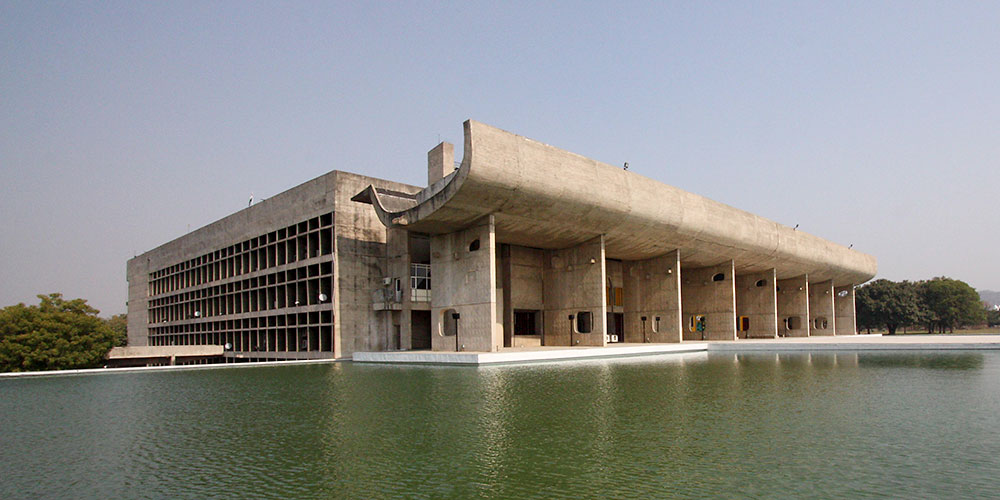The shape of freedom
Text: Simon Koenig
After independence, former colonies saw architecture as a way of remodeling their appearance. Often they chose the modernist style, which was, however, adapted in all sorts of ways. This is illustrated by a project focusing on India.
Modernism was understood as a universal language,” explains Pathmini Ukwattage, a student at the eikones graduate school, who is writing a dissertation on modernist architecture on the Indian subcontinent after 1945. “Modernism meant abstraction,” she says, “and, consequently, freedom and disengagement from all forms of tradition.”
For this reason, states that had gained their independence after the Second World War were highly receptive to the modernist view of architecture. It was an approach that appeared to complement the efforts of these newly independent countries to reconstitute and represent their own identities. “Modernism seemed to be free of nationality, religion, ethnicity and other cultural paradigms,” Ukwattage notes. Yet at the same time, it conveyed an ideal value – something truly democratic that everyone could understand. Concepts such as democracy and freedom were thus closely associated with the image of modernism.
New style versus old constraints
As Ukwattage points out, both postcolonial African and Asian countries and non -aligned states such as the former Yugoslavia sought to make this kind of statement. In doing so, their aim was also to define themselves as a credible alternative to the capitalist West and communist East – with a new style, to liberate themselves aesthetically from traditional constraints. Freedom and independence were portrayed and lived out through architecture and art.
The central premise of Ukwattage’s research is that modernism was appropriated in highly distinctive ways. “Naturally, something happened during the appropriation of modernist principles. That is the really interesting thing,” she explains. “In India, for example, we see the development of a distinctive architectural language, which modified the climatic, social and culturally specific parameters of the original, western-derived form.”
Modernist architecture, therefore, only starts out as a global style. In reality, the form assumed by modernist building in Sri Lanka and India differs slightly from that found in other parts of the world, as the architecture needed to take account of the tropical climate. Thus, for example, we find structures without windows or with clear passageways, which enable air to flow more freely. It goes without saying that these construction decisions influence the form and aesthetics of buildings.
According to Ukwattage, so-called fluid forms of this kind are perfectly compatible with modernist design principles. At the same time, however, traditional Indian architectural forms were adopted and assimilated to modernist architecture. This was because methods of regulating temperature have always been integral to architecture in India and Sri Lanka. Such examples show, first, that modernism does not exist in a pure form, and second, that it is an adaptable style with room for flexibility.
Le Corbusier in India
The city of Chandigarh is significant in this regard, as it marks the start of modernism’s reception in India. Ukwattage sees this planned city as a perfect example of the transcultural potential of the western concept of modernism in India. At independence, this former British colony was split into the separate states of India and Pakistan. The province of Punjab, which was affected by partition, lost its seat of government as a result. At the request of the Prime Minister, Jawaharlal Nehru, the Swiss-French architect Le Corbusier was commissioned to plan and manage the project to construct the capital for the Indian federal states of Punjab and Haryana.
Chandigarh is laid out as a grid structured around five different kinds of streets, ranging from highways down to cycle paths. “The city was patterned on the human body,” Ukwattage explains. “There is a ‘head’, where three huge government buildings – for the executive, the legislature and the judiciary – are located.” Streets that Le Corbusier termed lifelines lead to the “heart”, which is the site of important buildings such as theaters and museums, as well as local government buildings. These are surrounded by city districts, each with its own infrastructure for everyday life.
“All things considered, you can say that the city works,” Ukwattage stresses. Of course, there are some clear deficiencies – for example, because population growth far exceeded expectations and forecasts. “The infrastructure is too small, and suburban structures and slums have sprung up around the city.” Still, Le Corbusier’s sensitivity to and interest in the life, culture and climate of this Indian region helped make city life here a success. Chandigarh is not comparable to some of Le Corbusier’s other urban projects, which were often designed with little regard to context.
Modernism with freedom
Ukwattage sees the city’s success as due, in part, to Le Corbusier’s profound engagement with India. “In Chandigarh, he wanted to build a city that met the specific needs of the population.” That is why he included elements of traditional architecture and engaged intensively with Indian history and culture. For Le Corbusier and his architecture practice, which worked on the building project as a team, modernism did not mean imposing a style devoid of history and tradition.
In Chandigarh, modernism showed itself to be an architectural style and method suited to facilitating a break with the past. Here, India could be ultra-modern without harking back in visual terms to the former colonial power. The project also showed that there was sufficient scope for freedom and variation within modernism, as a stylistic vehicle, to enable it to respond in different ways to the geographical, social and climatic conditions that it encountered on the ground. Modernism can, therefore, be said to stand for a country’s freedom not just to celebrate and represent its newly won independence, but to live it out in appropriate ways.
More articles in the current issue of UNI NOVA.

